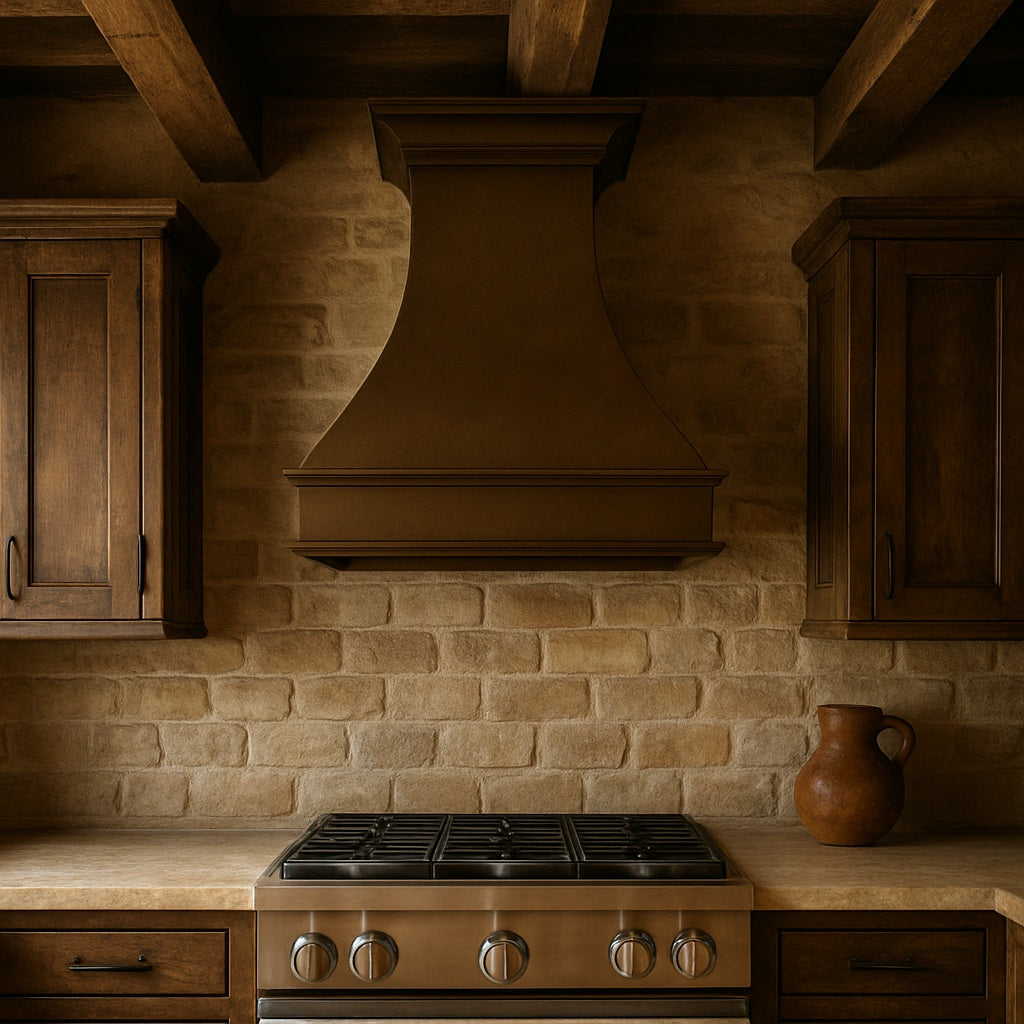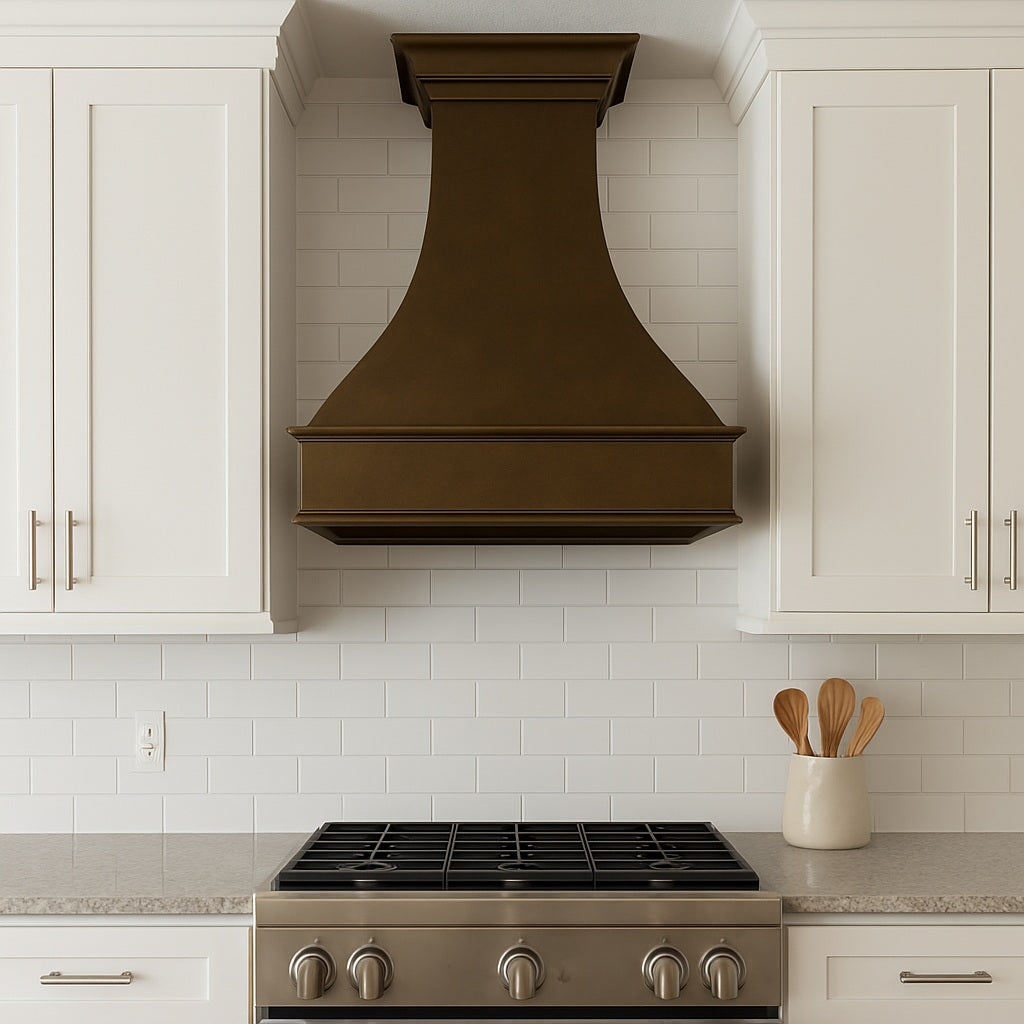
Spanish Revival Hammered Copper Kitchen Range Hood Guide
Share
Spanish Revival Hammered Copper Range Hood: A Living Focal Point for Your Kitchen
If you want a kitchen centerpiece that marries artisan heritage with dependable performance, the Spanish Revival hammered copper range hood delivers both presence and practicality. Explore specifications, finishes, and customization options on the product page at view this product page.

Old-World Character, Modern Performance
The essence of Spanish Revival design is warmth, texture, and graceful architecture that feels rooted in history. A hammered copper hood brings that spirit to life above your cooktop, giving the kitchen a sculptural focal point that earns attention from across the room. While the silhouette evokes mission and Mediterranean traditions, the internal ventilation components are tailored for contemporary cooking demands. That union of old and new is what makes this hood so compelling in real homes: its form reads like architecture, yet its function keeps up with the way you cook today.
Copper is the thread that ties these qualities together. Unlike factory-flat metals, a hand-hammered surface scatters light and deepens shadows, building visual dimension that shifts with the time of day. The patina grows richer as months and years pass, developing highlights along edges and subtle burnished areas where light grazes most often. The hood is not simply installed; it settles in and becomes part of the room’s story.
Why Copper
Copper’s relevance in the kitchen runs deeper than ornament. It withstands heat and moisture, resists corrosion, and can be finished to balance protection with natural aging. The hammered surface is more forgiving than a mirror-smooth finish, diffusing reflections to hide minor fingerprints while celebrating the artisan’s work. In practical terms, a properly sealed patina and routine mild cleaning are usually all the maintenance required. In aesthetic terms, copper offers a living color field that never feels static. Where painted or powder-coated metals mimic uniformity, copper embraces nuance, delivering a material that rewards close looking every day.
Style Notes
Spanish Revival kitchens often pair textured walls, arched details, and natural materials. This hood’s gentle flare and refined lines echo those architectural cues without overwhelming them. The body can be kept minimal for contemporary spaces or dressed with straps, rivets, or a decorative apron to lean traditional. Either way, the hood’s curve lifts the eye, and its mass grounds the cooking wall. Against plaster or stucco, it glows. Framed by shaker or flat-panel cabinetry, it introduces tactile contrast. Over an island, it reads as a hovering lantern of warm metal that centers the room.
Craft Methods
The difference between a commodity shell and an heirloom hood is the hand that forms it. Sheets of copper are heated, shaped, and hammered to establish the profile, then joined and finished with care so seams align and curves feel intentional. The hammering is not random texture; it is a rhythm that follows the hood’s geometry, animating surfaces while staying visually coherent. Patina work follows, where the finish is built in layers to reach a tone that suits your design—ranging from lighter fired hues to deeper coffee browns. A final seal can slow oxidation, or the finish can be left more open for a faster-maturing look, depending on your preference.
Ventilation Fit
Performance begins with a well-matched liner and blower. Because each hood is built to order, the copper shell is sized to the chosen ventilation insert instead of forcing your insert to fit a fixed envelope. This ensures proper capture area and clearance, maintains a quiet sound profile when paired with the right blower and duct size, and gives your installer predictable geometry for the duct run. If exterior venting is feasible, a straight, adequately sized duct is ideal. Where recirculating setups are necessary, charcoal filtration and regular filter changes keep the system efficient while preserving the hood’s clean exterior lines.
Sizing Guide
A helpful rule for residential cooking is to select a hood a few inches wider than the cooktop so it can capture steam and vapors at the edges. For example, a 36-inch range often pairs well with a 42-inch hood. Mounting height typically falls within the manufacturer’s recommendations to balance visual presence with effective capture. Because this hood is custom, chimney height and overall proportions can be adjusted to suit standard ceilings, vaulted spaces, or challenging transitions. The goal is proportionate scale: generous enough to feel architectural, restrained enough to harmonize with cabinetry and windows.
Design Pairings
Surrounding materials can either underscore tradition or nudge the composition modern. For a classic Revival palette, think plaster walls, saltillo or terracotta floors, hand-glazed tiles, and dark wood beams. The copper harmonizes with those earthy tones and textures. For a lighter transitional feel, keep cabinetry crisp and counters calm, then let the hood add warmth and movement. Consider iron lanterns or sconces that echo strap or rivet details. Choose hardware with a weathered finish to keep the metal dialogue cohesive rather than competing. The hood should look inevitable in the room, not added at the last minute.
Care Tips
Day-to-day upkeep is simple: wipe with a soft cloth and a mild, pH-neutral cleaner. Avoid abrasives and harsh chemicals that can disturb the patina. If you prefer a slower-aging surface, a periodic microcoat of beeswax or a copper-safe wax can help. If you enjoy the material’s natural evolution, skip the wax and watch the color deepen with time. The hammered texture hides minor marks and encourages a lived-in look. Should a small scratch occur, the patina often blends it naturally as the surface continues to oxidize. The best care routine is gentle, regular, and minimal.
Real Examples
Imagine a kitchen with arched doorways and hand-troweled walls. The copper hood rises above a range framed by a decorative tile surround, its hammered surface catching soft lamplight in the evening. In a different home with modern cabinetry and pale stone counters, the same hood brings warmth and sculptural relief, turning a clean-lined wall into something layered and tactile. In both scenarios, the hood is more than an appliance cover—it becomes the room’s visual anchor and a reminder that the space was made by people, for people.
Installation Notes
Good installation is the invisible half of beauty. Ensure proper blocking or structural support in the wall or ceiling before the hood arrives. Confirm the duct diameter your blower requires and plan the run to minimize unnecessary bends that add resistance. Set the mounting height to balance safety, code requirements, and capture effectiveness. Dry-fit the liner and confirm that controls are easily accessible. Concealed seams, level alignment, and precise transitions at the chimney make the difference between a handsome hood and a breathtaking one.
For Shopify
On a Shopify-based store, the story you tell around this hood matters as much as the specifications. Rich product content—clear photos, detail close-ups, and concise copy—helps shoppers picture the hood in their own homes. A blog post like this one deepens engagement: it explains why copper, how to size, how to care, and what to expect as the patina matures. Cross-linking from the article to the product page and vice versa streamlines the path from inspiration to purchase. Including a brief consultation prompt can also nudge hesitant buyers to share dimensions or style goals, letting your team propose the best configuration.
Customization
Custom work is where the design becomes yours. Prefer a darker espresso tone with subtly bright edges at the flare? Want a decorative apron with a period motif that echoes your tilework? Need the chimney extended to meet a twelve-foot ceiling, or shortened to sit beneath a beam? These are the decisions that transform a great hood into your great hood. The same goes for strap placement and rivet rhythm, which can add architectural punctuation to the body without turning it busy. With copper, restraint rarely reads as plain; the material’s depth does the heavy lifting.
Light And Time
One of copper’s pleasures is how it responds to light. Morning sun teases out warm highlights; evening pendants paint slow, liquid reflections across the hammered surface. As the room changes, the hood changes, too. Over seasons, the patina gathers character—the sort you cannot buy off the shelf. That evolving richness is the reward for choosing a living metal. In five years, you will have something better than new: a finish that acknowledges the meals, the gatherings, and the quiet moments that happened beneath it.
Quiet Power
Despite its visual heft, a well-paired liner keeps sound civilized. Overspec the duct size rather than underspec the blower; the right airflow at fewer revolutions often equals quieter performance. Strategic placement of make-up air and a clean, short duct run further reduce noise. The copper shell, once sealed around the insert, hides the work, leaving only soft fan tones and the glow of metal. That is the promise of a custom hood: robust function with a refined presence.
Home Value
A thoughtfully designed range wall boosts perceived value by signaling craftsmanship and intention. Buyers remember a kitchen with a commanding, beautiful hood. They remember the way the metal warmed the room and how the cooking station felt framed. Even if you are not selling, you are living with that memory every day. Investing in a handcrafted copper hood is not just an upgrade; it is a commitment to a room that earns its role as the heart of the home.
Closing Note
The Spanish Revival hammered copper range hood is more than a cover for a fan. It is an object with lineage, shaped by human hands and designed to age with you. If you are building or remodeling and want a focal point that feels both storied and fresh, let copper lead the way. And when you are ready to explore dimensions, finishes, and liner options, begin where the details live: visit the product listing at view this product page. From there, your kitchen’s centerpiece is only a few decisions away.
